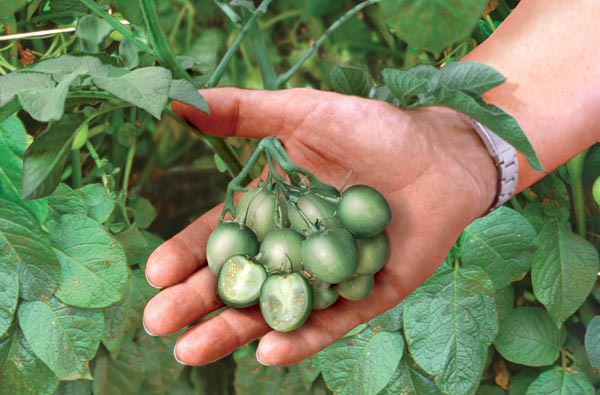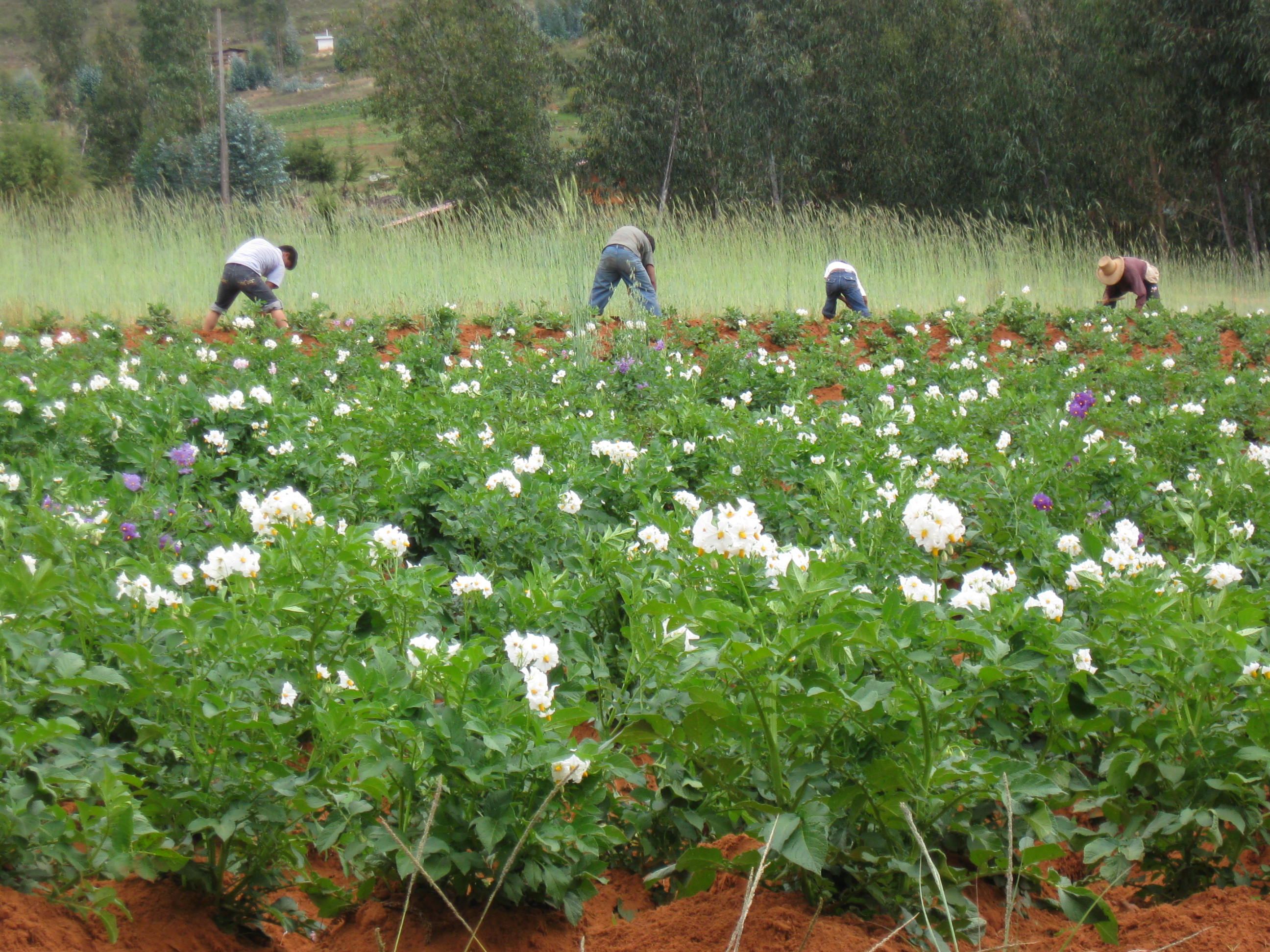Following a NY Times expose, here’s been much ado in the twittersphere about maca. But that’s not the only Andean tuber with a smuggling problem. Including to Italy, though?
European on farm diversification
In my previous post on the new EU Common Agricultural Policy, I missed that it promotes in situ conservation of crops. At least that is my reading of Annex IX, which provides a list of practices equivalent to crop diversification. The text is a bit confusing (why are legal documents never clear?); here’s an excerpt (my bolding):
- Crop Diversification
Requirement: at least three crops, the main crop covering a maximum of 75%, and any one or more of the following applying:
— there is a more appropriate selection of crops, such as, for example, leguminous, protein crops, crops not requiring irrigation or pesticide treatments, as appropriate,
— regional varieties of old, traditional or endangered crop types are included on at least 5% of the rotated area.
The ‘and‘ does not make sense, and should surely be ‘or‘? Otherwise there would be no ‘equivalency.’
Perhaps it is a European thing to emphasize the old & traditional over the novel & rare? Either way, there are busy times to come for European on farm conservation buffs! But where should interested farmers get seed? Many of these varieties may not be registered, and I thought that exchanging such seed was not legal in Europe?
The three crops rule
The European Union’s revised Common Agricultural Policy, effective from January 2015, has introduced a measure to promote agricultural diversification. The “Greening Payment” rewards farmers for practices perceived to be ‘beneficial for the climate and the environment’. It is big pot of money: 30% of the national level agricultural subsidies. Compliant farmers get a (per hectare) payment, offenders get a fine.
These are the Greening measures that farmers can take:
- ‘crop diversification’: cultivate at least 2 crops when a farm’s arable land exceeds 10 hectares and at least 3 crops when it exceeds 30 hectares. The main crop may cover at most 75% of the arable land, and the two main crops at most 95% of the arable land;
- maintaining an ‘ecological focus area’ of at least 5% of the arable area of the holding for farms with an area larger than 15 hectares (excluding permanent grassland) – i.e. field margins, hedges, trees, fallow land, landscape features, biotopes, buffer strips, afforested area;
- maintaining permanent grassland, including traditional orchards where fruit trees are grown in low density on grassland.
This is pretty complicated.
Farms that already have ‘Greening Equivalency’, such as organic producers, do not have to meet these requirements, because, says the EU, ‘their practices provide a clear ecological benefit’. There are more exceptions. For example for:
farms that already fulfill the objectives of crop diversification as a result of being covered to a significant extent by grassland or fallowland, for specialised farms rotating their parcels each year or for farms that because of their geographical localisation would have excessive difficulties in introducing a third crop.
I suppose it is on the basis of such ‘excessive difficulties’ that rice farms (at least in Andalucía) are exempt. Who else is going to be exempt? Why not include the thousand Scottish farmers that grow only one crop — spring barley for whisky? But that still leaves them muttering into their warm ales in the arable east of England, where opponents of the measure suggest that increasing crop diversity is less efficient and leads to more greenhouse gas emissions.
If these rules are here to stay, they will likely lead to creative book-keeping and a new agricultural land market to join, for example, a wheat farm with an olive grove, perhaps in different countries.
But what about the science behind all this? Research on “ecological focus areas” suggests that these may not deliver the goods. And there is no thought given to taxonomy: it is as green to grow wheat and barley as it is to grow beans and barley, or wheat and spelt.
Some of the most intensive (and, on a per ha basis, often the most environmentally problematic production systems) have more than three crops (not to mention horticulture). In the Netherlands, for example, most arable farms grow three crops or more: potato and wheat and perhaps sugarbeet, barley, onions, or another vegetable. This is part due to legal requirements on growing potatoes in a four year rotation in most regions, to reduce nematode (and nematicide) problems. These Dutch farms will get the subsidy, but a low input wheat farm in central Spain could get a fine.
What is the current baseline, and where does the EU think it will get with these rules? I could not find any analysis this is based on, can anyone point to that (if it exists)?
Here are some estimates of the areas affected in the UK. It is hard to get farm level crop diversity data; but we have statistics about crops by region, from which that can be estimated though. There’s something fun that I could do this week.
Brainfood: Garden pollinators, Herbarium Analytics, Rice & nutrients, High altitude barley, Sunflower hybrids, Coconut pollen cryo, Evolution & dormancy, Evolution of C4, Maize landraces, Viruses
- Culturally valuable minority crops provide a succession of floral resources for flower visitors in traditional orchard gardens. Proper gardens better for pollinators than unmanaged plots.
- Trends in access of plant biodiversity data revealed by Google Analytics. No impact of social media on the use of plant data, and the future is mobiles.
- Worldwide Genetic Diversity for Mineral Element Concentrations in Rice Grain. Most, though not all, elements showed high heritability, which is good news for breeders.
- Agriculture facilitated permanent human occupation of the Tibetan Plateau after 3600 BP. No barley, no Tibetans.
- Seed fates in crop-wild hybrid sunflowers: crop allele and maternal effects. Having wild mothers helps wild-crop hybrids survive in the wild.
- Coconut (Cocos nucifera l.) pollen cryopreservation. Eureka!
- The evolution of seed dormancy: environmental cues, evolutionary hubs, and diversification of the seed plants. More dormancy, more speciation.
- The evolutionary ecology of C4 plants. C4 opens new niches, but it’s all a matter of contingency and you have to follow the whole evolutionary history of a group to understand its current ecological strategy.
- A Minor Role for Environmental Adaptation in Local–Scale Maize Landrace Distribution: Results from a Common Garden Experiment in Oaxaca, Mexico. It’s the social factors, stupid.
- Crop immunity against viruses: outcomes and future challenges. PAMP (pathogen-associated molecular patterns)-triggered immunity (PTI) may be the future.
A natural experiment with Peruvian potatoes
Potatoes are generally propagated vegetatively, by planting tubers. In English, these tubers used for planting are, unfortunately, referred to as seed, which they obviously aren’t, at least not in the botanical sense. Potato breeders use sexual reproduction and the resulting real seeds (extracted from the tomato-like potato fruits) to generate new varieties. The fabled potato diversity of the Andes probably originated from seeds arising from spontaneous crosses among landraces and with their wild relatives, and alert farmers that kept some of the offspring occurring in their fields. But when and where were Andean potato varieties formed? And is this type of evolution still going on?
Marc Ghislain and colleagues 1 took advantage of a natural experiment in Peru to investigate whether new varieties have arisen from crosses between ‘Yungay’, and other varieties. Yungay 2 is one of the varieties of the famous Peruvian potato researcher Carlos Ochoa, produced by crossing native and exotic potatoes (from Europe, the USA, and Chiloe). Because it is genetically rather distinct from native Peruvian varieties (here is its pedigree), Ghislain and colleagues were able to use genetic markers (SSRs, in fact) to determine if a given potato variety in a farmer’s field might be an offspring of Yungay.
They looked at the DNA of 1771 leaf samples from more than 400 potato varieties growing in areas where Yungay is also grown. None of the potatoes sampled could plausibly be identified as a descendant of Yungay.
The authors’ motive was to find out whether transgenes from genetically modified potatoes might ‘pollute’ native diversity. I am more interested in the question of whether farmers are still finding, keeping and spreading new varieties from spontaneous seedlings. That would seem likely, but there appears to be no good evidence that they do so. We know that hybridization among potato cultivars, and with wild species, occurs under field conditions, but what happens to the offspring? Ghislain and his colleagues suggest that hybrids may not be adapted, and thus die off, citing research carried out in the rather unforgiving climate of Puno, and that farmers discard hybrids because they prize the quality of native varieties. But I am not convinced by that argument. Clearly, many hybrids will not make the cut, as in any breeding program, but some novelty must surely be of interest to local farmers, as it obviously has been in the past.
Is keeping new potato varieties a cultural practice that has been lost? And are most current native potato varieties therefore old, perhaps very old? Or is the process still going on, perhaps even at a similar rate as before, but the chance of detecting it is small? I wonder if there is some sort of clock that can be used to measure how old a variety is. After all, a variety is really an individual clonally propagated plant. And some potato varieties are thus of course much larger organisms than those molds that occasionally hit the headlines; each year there are about 10,000 ha of Russet Burbank in the USA alone.
Unless there is simply something wrong with Yungay’s offspring (which would make it a bad variety to use for this type of research), my guess is that there are hybrids with Yungay out there, but not many, and that they are just very hard to find. Only very few novel varieties may be good enough to spread beyond a farm to a much larger area, such that we are likely to detect them. But a transgene hybrid could have better odds than most.

